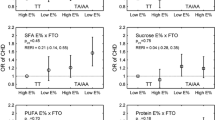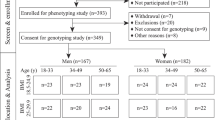Abstract
Diet is an important environmental factor interacting with our genes to modulate the likelihood of developing lipid disorders and, consequently, cardiovascular disease risk. Our objective was to study whether dietary intake modulates the association between APOA5 gene variation and body weight in a large population-based study. Specifically, we have examined the interaction between the APOA5–1131T>C and 56C>G (S19W) polymorphisms and the macronutrient intake (total fat, carbohydrate, and protein) in their relation to the body mass index (BMI) and obesity risk in 1,073 men and 1,207 women participating in the Framingham Offspring Study. We found a consistent and statistically significant interaction between the −1131T>C single-nucleotide polymorphism (SNP; but not the 56C>G) and total fat intake for BMI. This interaction was dose-dependent, and no statistically significant heterogeneity by gender was detected. In subjects homozygous for the −1131T major allele, BMI increased as total fat intake increased. Conversely, this increase was not present in carriers of the −1131C minor allele. Accordingly, we found significant interactions in determining obesity and overweight risks. APOA5–1131C minor allele carriers had a lower obesity risk (OR, 0.61, 95%; CI, 0.39–0.98; P = 0.032) and overweight risk (OR, 0.63, 95%; CI, 0.41–0.96; P = 0.031) compared with TT subjects in the high fat intake group (≥30% of energy ) but not when fat intake was low (OR, 1.16, 95%; CI, 0.77–1.74; P = 0.47 and OR = 1.15, 95%; CI, 0.77–1.71; P = 0.48) for obesity and overweight, respectively). When specific fatty acid groups were analyzed, monounsaturated fatty acids showed the highest statistical significance for these interactions. In conclusion, the APOA5–1131T>C SNP, which is present in approximately 13% of this population, modulates the effect of fat intake on BMI and obesity risk in both men and women.


Similar content being viewed by others
References
Cambien F (2005) Coronary heart disease and polymorphisms in genes affecting lipid metabolism and inflammation. Curr Atheroscler Rep 7:188–195
Lai CQ, Parnell LD, Ordovas JM (2005) The APOA1/C3/A4/A5 gene cluster, lipid metabolism and cardiovascular disease risk. Curr Opin Lipidol 16:153–166
Pajukanta P (2004) Do DNA sequence variants in ABCA1 contribute to HDL cholesterol levels in the general population? J Clin Invest 114(9):1244–1247
Semple RK, Chatterjee VK, O’Rahilly S (2006) PPAR gamma and human metabolic disease. J Clin Invest 116:581–589
Yang Q, Khoury MJ (1997) Evolving methods in genetic epidemiology. III. Gene–environment interaction in epidemiologic research. Epidemiol Rev 19:33–43
Khoury MJ, Davis R, Gwinn M, Lindegren ML, Yoon P (2005) Do we need genomic research for the prevention of common diseases with environmental causes? Am J Epidemiol 161:799–805
Hunter DJ (2005) Gene-environment interactions in human diseases. Nat Rev Genet 6:287–298
Grigorenko EL (2005)The inherent complexities of gene-environment interactions. J Gerontol B Psychol Sci Soc Sci 60:53–64
Ordovas JM, Corella D (2004) Nutritional genomics. Annu Rev Genomics Hum Genet 5:71–118
Mutch DM, Wahli W, Williamson G (2005) Nutrigenomics and nutrigenetics: the emerging faces of nutrition. FASEB J 19:1602–1616
Afman L, Muller M (2006) Nutrigenomics: from molecular nutrition to prevention of disease. J Am Diet Assoc 106:569–576
Corella D, Ordovas JM (2005) Single nucleotide polymorphisms that influence lipid metabolism: interaction with dietary factors. Annu Rev Nutr 25:341–390
Ordovas JM, Corella D, Demissie S, Cupples LA, Couture P, Coltell O, Wilson PW, Schaefer EJ, Tucker KL (2002) Dietary fat intake determines the effect of a common polymorphism in the hepatic lipase gene promoter on high-density lipoprotein metabolism: evidence of a strong dose effect in this gene-nutrient interaction in the Framingham Study. Circulation 106:2315–2321
Dwyer JH, Allayee H, Dwyer KM, Fan J, Wu H, Mar R, Lusis AJ, Mehrabian M (2004) Arachidonate 5-lipoxygenase promoter genotype, dietary arachidonic acid, and atherosclerosis. N Engl J Med 350:29–37
Corella D, Tucker K, Lahoz C, Coltell O, Cupples LA, Wilson PW, Schaefer EJ, Ordovas JM (2001) Alcohol drinking determines the effect of the APOE locus on LDL-cholesterol concentrations in men: the Framingham Offspring Study. Am J Clin Nutr 73:736–745
Memisoglu A, Hu FB, Hankinson SE, Manson JE, De Vivo I, Willett WC, Hunter DJ (2003) Interaction between a peroxisome proliferator-activated receptor gamma gene polymorphism and dietary fat intake in relation to body mass. Hum Mol Genet 12:2923–2929
Miyaki K, Sutani S, Kikuchi H, Takei I, Murata M, Watanabe K, Omae K (2005) Increased risk of obesity resulting from the interaction between high energy intake and the Trp64Arg polymorphism of the beta3-adrenergic receptor gene in healthy Japanese men. J Epidemiol 15:203–210
Marques-Vidal P, Bongard V, Ruidavets JB, Fauvel J, Hanaire-Broutin H, Perret B, Ferrieres J (2003) Obesity and alcohol modulate the effect of apolipoprotein E polymorphism on lipids and insulin. Obes Res 11:1200–1206
Elosua R, Demissie S, Cupples LA, Meigs JB, Wilson PW, Schaefer EJ, Corella D, Ordovas JM (2003) Obesity modulates the association among APOE genotype, insulin, and glucose in men. Obes Res 11:1502–1508
Corella D, Ordovas JM (2004) The metabolic syndrome: a crossroad for genotype–phenotype associations in atherosclerosis. Curr Atheroscler Rep 6:186–196
Elosua R, Ordovas JM, Cupples LA, Lai CQ, Demissie S, Fox CS, Polak JF, Wolf PA, D’Agostino RB Sr, O’donnell CJ (2006) Variants at the APOA5 locus, association with carotid atherosclerosis, and modification by obesity: the Framingham Study. J Lipid Res 47:990–996
Lai CQ, Corella D, Demissie S, Cupples LA, Adiconis X, Zhu Y, Parnell LD, Tucker KL, Ordovas JM (2006) Dietary intake of n-6 fatty acids modulates effect of apolipoprotein A5 gene on plasma fasting triglycerides, remnant lipoprotein concentrations, and lipoprotein particle size: the Framingham Heart Study. Circulation 113:2062–2070
Pennacchio LA, Olivier M, Hubacek JA, Cohen JC, Cox DR, Fruchart JC, Krauss RM, Rubin EM (2001) An apolipoprotein influencing triglycerides in humans and mice revealed by comparative sequencing. Science 294:169–173
Talmud PJ, Hawe E, Martin S, Olivier M, Miller GJ, Rubin EM, Pennacchio LA, Humphries SE (2002) Relative contribution of variation within the APOC3/A4/A5 gene cluster in determining plasma triglycerides. Hum Mol Genet 11:3039–3046
Lai CQ, Tai ES, Tan CE, Cutter J, Chew SK, Zhu YP, Adiconis X, Ordovas JM (2003) The APOA5 locus is a strong determinant of plasma triglyceride concentrations across ethnic groups in Singapore. J Lipid Res 44:2365–2373
Lai CQ, Demissie S, Cupples LA, Zhu Y, Adiconis X, Parnell LD, Corella D, Ordovas JM (2004) Influence of the APOA5 locus on plasma triglyceride, lipoprotein subclasses, and CVD risk in the Framingham Heart Study. J Lipid Res 45:2096–2105
Hodoglugil U, Tanyolac S, Williamson DW, Huang Y, Mahley RW (2006) Apolipoprotein A–V: a potential modulator of plasma triglyceride levels in Turks. J Lipid Res 47:144–153
Pennacchio LA, Olivier M, Hubacek JA, Krauss RM, Rubin EM, Cohen JC (2002) Two independent apolipoprotein A5 haplotypes influence human plasma triglyceride levels. Hum Mol Genet 11:3031–3038
Merkel M, Heeren J (2005) Give me A5 for lipoprotein hydrolysis! J Clin Invest 115:2694–2696
Merkel M, Loeffler B, Kluger M, Fabig N, Geppert G, Pennacchio LA, Laatsch A, Heeren J (2005) Apolipoprotein AV accelerates plasma hydrolysis of triglyceride-rich lipoproteins by interaction with proteoglycan-bound lipoprotein lipase. Biol Chem 280:21553–21560
Mead JR, Irvine SA, Ramji DP (2002) Lipoprotein lipase: structure, function, regulation, and role in disease. J Mol Med 80:753–769
Koike T, Liang J, Wang X, Ichikawa T, Shiomi M, Liu G, Sun H, Kitajima S, Morimoto M, Watanabe T, Yamada N, Fan J (2004) Overexpression of lipoprotein lipase in transgenic Watanabe heritable hyperlipidemic rabbits improves hyperlipidemia and obesity. J Biol Chem 279:7521–7529
Prieur X, Coste H, Rodriguez JC (2003) The human apolipoprotein AV gene is regulated by peroxisome proliferator-activated receptor-alpha and contains a novel farnesoid X-activated receptor response element. J Biol Chem 278:25468–25480
Prieur X, Huby T, Coste H, Schaap FG, Chapman MJ, Rodriguez JC (2005) Thyroid hormone regulates the hypotriglyceridemic gene APOA5. J Biol Chem 280:27533–27543
Feinleib M, Kannel WB, Garrison RJ, McNamara PM, Castelli WP (1975) The Framingham Offspring Study. Design and preliminary data. Prev Med 4:518–525
Osgood D, Corella D, Demissie S, Cupples LA, Wilson PW, Meigs JB, Schaefer EJ, Coltell O, Ordovas JM (2003) Genetic variation at the scavenger receptor class B type I gene locus determines plasma lipoprotein concentrations and particle size and interacts with type 2 diabetes: the Framingham Study. J Clin Endocrinol Metab 88:2869–2879
Rimm EB, Giovannucci EL, Stampfer MJ, Colditz GA, Litin LB, Willett WC (1992) Reproducibility and validity of an expanded self-administered semiquantitative food frequency questionnaire among male health professionals. Am J Epidemiol 135:1114–1126
Henneman P, Schaap FG, Havekes LM, Rensen PC, Frants RR, van Tol A, Hattori H, Smelt AH, van Dijk KW (2006) Plasma apoAV levels are markedly elevated in severe hypertriglyceridemia and positively correlated with the APOA5 S19W polymorphism. Atherosclerosis (in press)
Klos KL, Hamon S, Clark AG, Boerwinkle E, Liu K, Sing CF (2005) APOA5 polymorphisms influence plasma triglycerides in young, healthy African Americans and whites of the CARDIA Study. J Lipid Res 46:564–571
Hubacek JA, Skodova Z, Adamkova V, Lanska V, Poledne R (2004) The influence of APOAV polymorphisms (T-1131>C and S19>W) on plasma triglyceride levels and risk of myocardial infarction. Clin Genet 65:126–130
Lee KW, Ayyobi AF, Frohlich JJ, Hill JS (2004) APOA5 gene polymorphism modulates levels of triglyceride, HDL cholesterol and FERHDL but is not a risk factor for coronary artery disease. Atherosclerosis 176:165–172
Aberle J, Evans D, Beil FU, Seedorf U (2005) A polymorphism in the apolipoprotein A5 gene is associated with weight loss after short-term diet. Clin Genet 68:152–154
Martin S, Nicaud V, Humphries SE, Talmud PJ; EARS Group (2003) Contribution of APOA5 gene variants to plasma triglyceride determination and to the response to both fat and glucose tolerance challenges. Biochim Biophys Acta 1637:217–225
Memisoglu A, Hu FB, Hankinson SE, Manson JE, De Vivo I, Willett WC, Hunter DJ (2003) Interaction between a peroxisome proliferator-activated receptor gamma gene polymorphism and dietary fat intake in relation to body mass. Hum Mol Genet 12:2923–2929
Martinelli N, Trabetti E, Bassi A, Girelli D, Friso S, Pizzolo F, Sandri M, Malerba G, Pignatti PF, Corrocher R, Olivieri O (2006) The −1131 T>C and S19W APOA5 gene polymorphisms are associated with high levels of triglycerides and apolipoprotein C-III, but not with coronary artery disease: an angiographic study. Atherosclerosis (in press)
Liu H, Zhang S, Lin J, Li H, Huang A, Xiao C, Li X, Su Z, Wang C, Nebert DW, Zhou B, Zheng K, Shi J, Li G, Huang D (2005) Association between DNA variant sites in the apolipoprotein A5 gene and coronary heart disease in Chinese. Metabolism 54:568–572
Ruiz-Narvaez EA, Yang Y, Nakanishi Y, Kirchdorfer J, Campos H (2005) APOC3/A5 haplotypes, lipid levels, and risk of myocardial infarction in the Central Valley of Costa Rica. J Lipid Res 46:2605–2613
Szalai C, Keszei M, Duba J, Prohaszka Z, Kozma GT, Csaszar A, Balogh S, Almassy Z, Fust G, Czinner A (2004) Polymorphism in the promoter region of the apolipoprotein A5 gene is associated with an increased susceptibility for coronary artery disease. Atherosclerosis 173:109–114
Acknowledgment
This study was supported by the National Heart, Lung, and Blood Institute contract N01-HC-25195 and grant HL-54776, by contracts 53-K06-5-10 and 58-1950-9-001 from the US Department of Agriculture Research Service, and by grants from the American Heart Association (0335432T) and the Spanish Ministerio de Educación y Ciencia (PR2006-0258) and the Spanish Ministeriode Sanidad (CB06/03/0035).
Author information
Authors and Affiliations
Corresponding author
Rights and permissions
About this article
Cite this article
Corella, D., Lai, CQ., Demissie, S. et al. APOA5 gene variation modulates the effects of dietary fat intake on body mass index and obesity risk in the Framingham Heart Study. J Mol Med 85, 119–128 (2007). https://doi.org/10.1007/s00109-006-0147-0
Received:
Revised:
Accepted:
Published:
Issue Date:
DOI: https://doi.org/10.1007/s00109-006-0147-0




